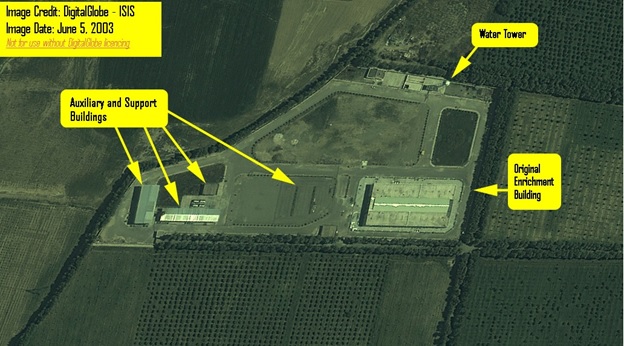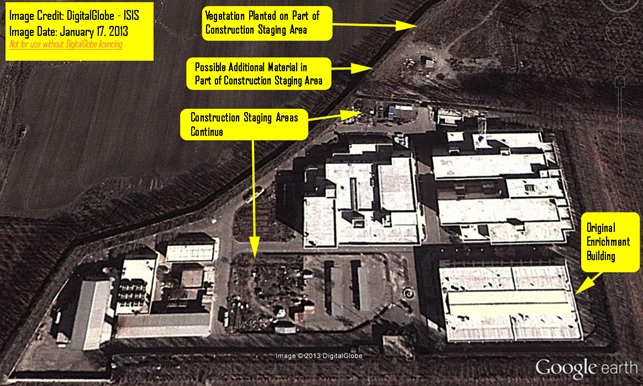Reports
Update on Lashkar Ab’ad: Iran’s Laser Enrichment Capabilities
by David Albright and Serena Kelleher-Vergantini
February 24, 2014
On February 8 and 9, 2014, the International Atomic Energy (IAEA) and Iran held technical meetings within the Framework for Cooperation that was agreed between the parties in November 2013. Iran and the IAEA reached an agreement on seven practical measures Iran must implement by May 15, 2014, including one provision where Iran agreed to provide “mutually agreed relevant information and arranging for a technical visit to Lashkar Ab’ad Laser Centre,” the former location of Iran’s past undeclared uranium laser enrichment work. 1
This measure adds to an earlier one negotiated within the Framework for Cooperation in November 2013, in which Iran agreed to further clarify its 2010 announcement about its capability to enrich uranium with lasers. 2 According to the February 2014 IAEA Iran safeguards report, Iran at least partially explained this 2010 announcement. To resolve the outstanding concerns about laser enrichment, Iran will need to provide much greater cooperation than demonstrated so far.
Earlier ISIS Report on Iranian Laser Enrichment
In a 2013 ISIS Imagery Brief, ISIS used commercial satellite imagery to investigate the Lashkar Ab’ad site, where Iran conducted secret laser enrichment activities into 2003. Since this site was originally the home of a facility involved in a major violation of Iran’s safeguards agreement, the IAEA would want on-going visits to this site, particularly since it has remained involved in related activities, namely laser research and development. As described in the Imagery Brief, the IAEA is also expected to want to scrutinize this issue in more depth because Iran has taken other steps that have compounded suspicions that it has revived uranium laser enrichment activities. It has developed advanced lasers suitable for uranium enrichment, undertaken extensive construction at the Lashkar Ab’ad site during the last several years (see figures 1 and 2), and made a 2010 high-profile announcement about having a uranium laser enrichment capability.
The 2010 statement was made by then President Mahmoud Ahmadinejad during a major exhibition sponsored by Iran’s National Center for Laser Science and Technology. He stated: “Today, we are capable of enriching uranium with lasers. It is now possible to do this using the same devices which are on display here in this exhibition”3 and that “using the laser technology for enriching uranium would lead to carrying out the enrichment process with a higher quality, accuracy and speed.”4 Former President Ahmadinejad stated that “the Iranian scientists have acquired the laser- operating uranium enrichment know-how but would put the technology on shelf for the moment.” 5
Laser enrichment poses a proliferation threat because, if properly engineered, it has the potential to dramatically advance the capabilities of proliferant states to secretly enrich uranium. Although enriching uranium with lasers on a production-scale appears extremely complicated, laser enrichment of uranium warrants concern as a potential way for a proliferant state to acquire significant quantities of highly enriched uranium. A covert laser uranium enrichment facility might escape detection by the IAEA and Western intelligence services because of the relatively small size and few external indicators of such plants. Additionally, Iran could conduct several necessary research and development activities of laser uranium enrichment under a non-nuclear cover.
Iran’s Initial Clarification on 2010 Announcement
In a January 18, 2014 letter to the IAEA, Iran stated that the 2010 statement was made based on its “past R&D experiences in the field of laser enrichment which ended in 2003” and that since then “there had not been any especially designed or prepared systems, equipment and components for use in laser-based enrichment plants in Iran.” 6 This statement appears to include that Iran has not operated a secret laser enrichment plant since 2003. This is a welcome statement, and it meets the requirement to “further clarify” the 2010 announcement, although one has to accept that it remains unverified by the IAEA. There is a more fundamental problem with the answer. It does not address the key concern raised by the 2010 announcement, namely that Iran is developing further its capability to enrich uranium with lasers, much of which would not involve actually using “especially designed or prepared” systems. Its current answer shows that Iran so far has taken a minimal approach to addressing the IAEA’s concerns about laser enrichment.
Next Measure
Under the new measure, Iran is to provide the IAEA with additional relevant information and arrange for a technical visit to Lashkar Ab’ad Laser Center. Iran should provide enough information and a sufficiently detailed technical visit to allow the IAEA to assess the status of Iran’s work on laser enrichment, including its current relevant developments and its future plans. Iran should also make available Iranian experts who can address the IAEA’s technical questions.


1. “IAEA and Iran Conclude Talks in Connection with Implementation of Framework for Cooperation,” IAEA, February 9, 2014, http://www.iaea.org/newscenter/news/2014/iaea_iran090214.html. 2. David Albright and Andrea Stricker, Iran’s Negotiating Track with the IAEA, ISIS Report, November 26, 2013. http://isis-online.org/isis-reports/detail/irans-negotiating-track-with-the-iaea/8 3. “Iran’s Latest Achievements in Laser Technology,” Iran Press TV video, February 8, 2010. http://www.youtube.com/watch?v=8snVEsyzvK4. 4. “Good Nuclear News, Iran Possesses Laser Enrichment Technology,” Presidency of the Islamic Republic of Iran Website, February 7, 2010, http://www.president.ir/en/20255 5. “Iran Scientists Gain Full Access to Laser Tech,” Islamic Invitation Turkey, February 8, 2010. 6. Director General, IAEA, Implementation of the NPT Safeguards Agreement in the Islamic Republic of Iran, GOV/2014/10, February 20, 2014, http://isis-online.org/uploads/isis-reports/documents/iaea-iranreport-02202014.pdf.

 twitter
twitter